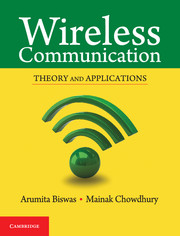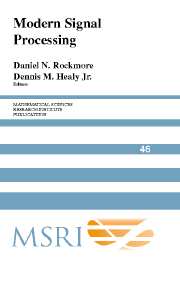Refine listing
Actions for selected content:
9096 results in Communications, Signal Processing and Information Theory

Computer Vision
- Fundamentals and Applications
- Coming soon
-
- Expected online publication date:
- September 2025
- Print publication:
- 30 September 2025
-
- Textbook
- Export citation

Wireless Communication
- Theory and Applications
-
- Published online:
- 21 July 2025
- Print publication:
- 16 January 2017
-
- Textbook
- Export citation

Modern Signal Processing
-
- Published online:
- 25 June 2025
- Print publication:
- 05 April 2004
11 - Structural Results for Optimal Filters
- from Part III - POMDP Structural Results
-
- Book:
- Partially Observed Markov Decision Processes
- Published online:
- 16 May 2025
- Print publication:
- 05 June 2025, pp 282-311
-
- Chapter
- Export citation
Appendix A - Short Primer on Stochastic Simulation
-
- Book:
- Partially Observed Markov Decision Processes
- Published online:
- 16 May 2025
- Print publication:
- 05 June 2025, pp 570-584
-
- Chapter
- Export citation
Appendix B - Continuous-Time HMM Filters
-
- Book:
- Partially Observed Markov Decision Processes
- Published online:
- 16 May 2025
- Print publication:
- 05 June 2025, pp 585-592
-
- Chapter
- Export citation
19 - Discrete Stochastic Optimization
- from Part IV - Stochastic Gradient Algorithms and Reinforcement Learning
-
- Book:
- Partially Observed Markov Decision Processes
- Published online:
- 16 May 2025
- Print publication:
- 05 June 2025, pp 509-522
-
- Chapter
- Export citation
3 - Optimal Filtering
- from Part I - Stochastic Models and Bayesian Inference
-
- Book:
- Partially Observed Markov Decision Processes
- Published online:
- 16 May 2025
- Print publication:
- 05 June 2025, pp 34-70
-
- Chapter
- Export citation
18 - Stochastic Gradient Algorithms. Convergence Analysis
- from Part IV - Stochastic Gradient Algorithms and Reinforcement Learning
-
- Book:
- Partially Observed Markov Decision Processes
- Published online:
- 16 May 2025
- Print publication:
- 05 June 2025, pp 466-508
-
- Chapter
- Export citation
13 - Structural Results for Stopping-Time POMDPs
- from Part III - POMDP Structural Results
-
- Book:
- Partially Observed Markov Decision Processes
- Published online:
- 16 May 2025
- Print publication:
- 05 June 2025, pp 327-375
-
- Chapter
- Export citation
Part III - POMDP Structural Results
-
- Book:
- Partially Observed Markov Decision Processes
- Published online:
- 16 May 2025
- Print publication:
- 05 June 2025, pp 255-256
-
- Chapter
- Export citation
15 - Myopic Policy Bounds for POMDPs and Sensitivity to Model Parameters
- from Part III - POMDP Structural Results
-
- Book:
- Partially Observed Markov Decision Processes
- Published online:
- 16 May 2025
- Print publication:
- 05 June 2025, pp 401-422
-
- Chapter
- Export citation
1 - Introduction
-
- Book:
- Partially Observed Markov Decision Processes
- Published online:
- 16 May 2025
- Print publication:
- 05 June 2025, pp 1-8
-
- Chapter
-
- You have access
- Export citation
Part V - Inverse Reinforcement Learning
-
- Book:
- Partially Observed Markov Decision Processes
- Published online:
- 16 May 2025
- Print publication:
- 05 June 2025, pp 523-524
-
- Chapter
- Export citation
Appendix C - Discrete-Time Martingales
-
- Book:
- Partially Observed Markov Decision Processes
- Published online:
- 16 May 2025
- Print publication:
- 05 June 2025, pp 593-595
-
- Chapter
- Export citation
Index
-
- Book:
- Partially Observed Markov Decision Processes
- Published online:
- 16 May 2025
- Print publication:
- 05 June 2025, pp 629-636
-
- Chapter
- Export citation
Part I - Stochastic Models and Bayesian Inference
-
- Book:
- Partially Observed Markov Decision Processes
- Published online:
- 16 May 2025
- Print publication:
- 05 June 2025, pp 9-10
-
- Chapter
- Export citation
Appendix D - Markov Processes
-
- Book:
- Partially Observed Markov Decision Processes
- Published online:
- 16 May 2025
- Print publication:
- 05 June 2025, pp 596-597
-
- Chapter
- Export citation
Appendix F - Summary of POMDP Algorithms
-
- Book:
- Partially Observed Markov Decision Processes
- Published online:
- 16 May 2025
- Print publication:
- 05 June 2025, pp 602-604
-
- Chapter
- Export citation
6 - Nonparametric Bayesian Inference
- from Part I - Stochastic Models and Bayesian Inference
-
- Book:
- Partially Observed Markov Decision Processes
- Published online:
- 16 May 2025
- Print publication:
- 05 June 2025, pp 114-162
-
- Chapter
- Export citation
